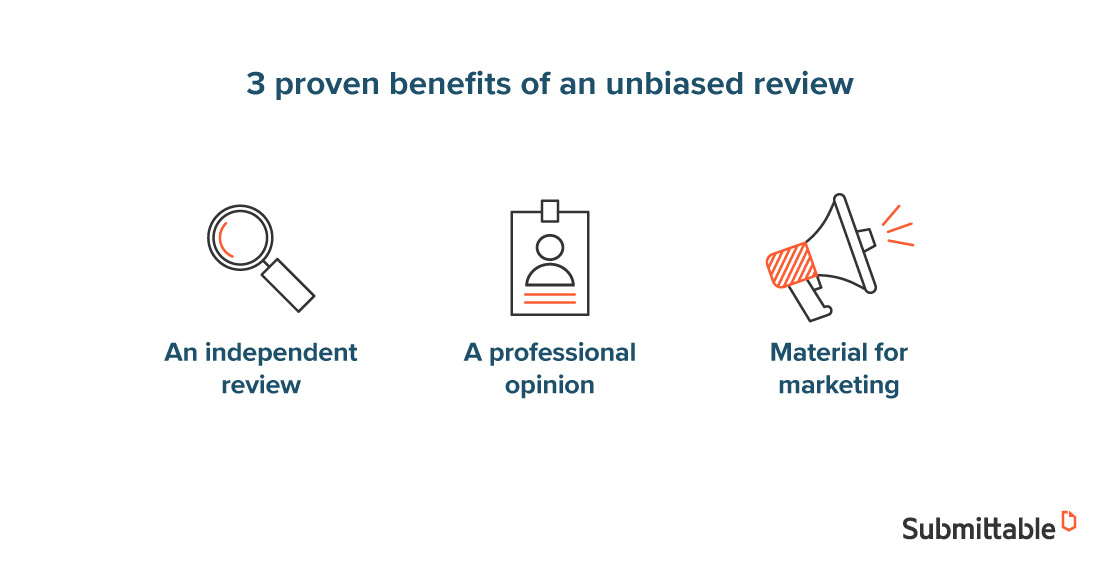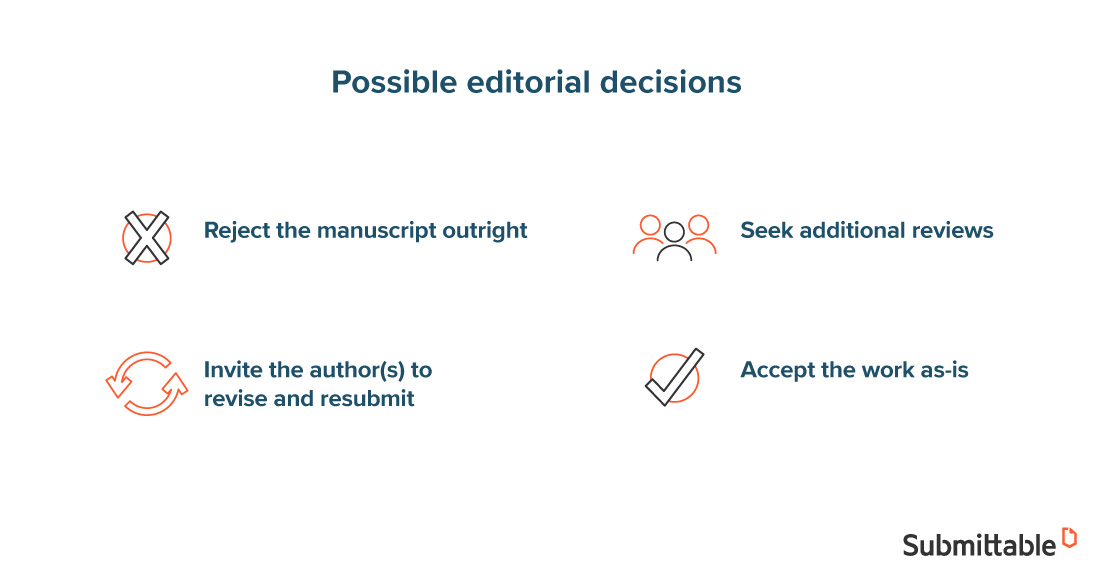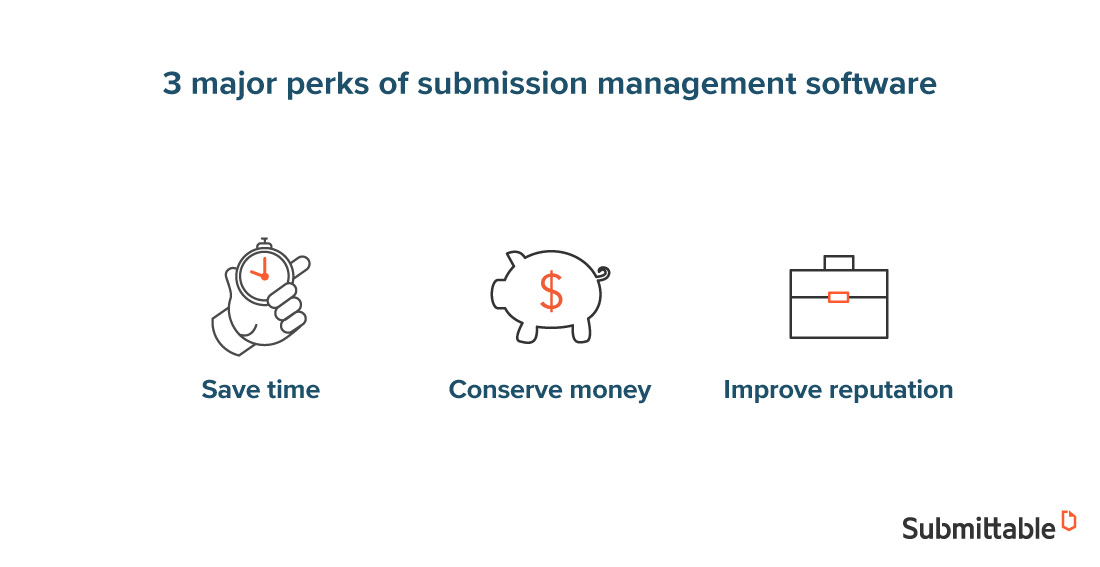It’s your time and your choice.
As a publisher, your editorial review process can mean the difference between you quickly and easily filtering through manuscripts, and wasting time and energy sifting through low quality work.
To ensure the submissions you publish are of the highest quality, you need an effective editorial review process.
Whether you’re a trade publisher or a scholarly journal, you’ll want to make sure you have an efficient system for filtering submissions and moving items through the review process without hassle.
A thorough editorial review process is performed by professional editors and helps writers get their manuscripts into better shape. Here’s a bit more on how to get that done at the tactical level.
The benefits of an editorial review

An unbiased reviewer
The purpose of an editorial review is to provide extra clarity on the technical and functional aspects of a piece of work. Writers can’t truly edit their own work because the mind has a tendency to automatically fill gaps. Having an editor allows for an objective look at the writing.
A professional opinion
An editorial review involves a writing and editing expert dedicating time to evaluate the work. The reviewers are often experts in that specific niche and can let readers know how the work compares to similar pieces. Expert reviews can greatly support the revision and editing phases while preparing a work for publication.
Opportunities for marketing
Editorial reviews are built-in testimonials and advertisements. Third-party recommendations are almost always given more significance than self-promotion. When people are considering making a purchase they want to know from an objective source what to expect and why they should buy.
Telling people your work is great is one thing. Other people saying your work is great is far more powerful.
Editorial review breakdown: The manuscript review workflow
The manuscript review process should ensure all manuscripts meet the basic standards of peer review. This process can be broken down into several steps.
Editorial review
Don’t waste time on submissions that aren’t even up to par. The first step in the manuscript review process is editorial review.
During this stage, reviewers evaluate how well the submission fits the scope of set criteria.
Post-review, there are three basic choices:
- Reject the submission
- Accept the submission and send it to peer review
- Request a revised submission. The original submission is returned with notes and instructions for edits to be made. Once standards are met, the piece can be submitted again
Quickly filtering content when it’s first submitted can save a lot of time and effort for you on the back end. You’ll want to ensure that submissions moving through the funnel are well-qualified.
Peer review
After a submission is approved, it can then be reviewed by a small group of peers.
During the peer review process, professional reviewers that are familiar with the niche and subject matter of the submission are assigned by an editor to evaluate the work.
The professional reviewers then analyze it and leave detailed notes and recommendations.
A good peer review goes beyond normal reviewing standards and explores how important the work is, the suitability of its methods, and if the discussions within the submission are balanced and logical.
These reviews are then collected and submitted back to the original editor so they can make an editorial decision.
Editorial decisions

After peer reviews are submitted you’re almost in the home stretch.
Now it’s decision time.
The editor will objectively evaluate the peer reviews and decide whether to:
- Reject the manuscript outright
- Invite the author(s) to revise and resubmit
- Seek additional reviews
- Accept the work as-is
Then the editor sends their decision to the primary author along with the masked comments of the peer reviewers.
The reviewers will include their own personal recommendations in those comments.
Be aware that this final portion of the review process can take multiple revisions and submissions before everything is finally complete.
Finally, it’ll be up to the editor to decide if a manuscript is ready or not and collaborate with the author on next steps.
For a real-world example of an organization that’s committed to optimizing their editorial process, take a look at how the platform helped the University Press of Colorado streamline their editorial review system. Darrinn Pratt, University Press of Colorado Director, shared how their submission platform makes life easier for him and his team.
Use technology to streamline the editorial process

So we’ve walked through what the editorial process looks like from a pure process perspective.
Now let’s talk about the benefits of streamlining your editorial process, with technology that allows you to save time, add some prestige to your organization, and save money.
The accessibility, automation, ease of use, and speed that a submission management software offers can really empower your team to enhance their current process.
Save time
One of the biggest impacts editorial workflow software offers is time-savings.
With the right submission platform, you can drastically reduce the time spent on manually tracking individual submissions through the review process.
Conserve money
If you’re going to embark on the journey of implementing a software-based solution, you’ll want to know if it’s helping or hurting your bottom line.
Luckily, the administrative time you save processing manuscripts justifies the subscription cost of a platform that helps you automate the editorial process. That time can now be spent improving the quality of editing, and the cost savings can be invested in growing your business.
Improve your professional reputation
If you’ve worked with multiple organizations you have probably experienced the difference between an organization that takes advantage of the latest technology to make things easier and an organization that’s stuck using outdated methods.
Organizations that fall far behind when it comes to technology can come across as unprofessional and unprepared.
No company wants to scare off current or potential talent because they’re behind the times or even worse—costing their customers valuable hours.
Don’t be that organization.
Build efficient editorial workflows with the right submission tools
The ideal submission software will help your reviewers and authors move seamlessly through the editorial review process. At each step, communication with stakeholders should be robust and offer sufficient information to keep the process moving fluidly.
Here’s a breakdown of what that process should look like:
Editorial workflow
- Submission – In this stage, submissions are received and assigned to editors who will decide if they’re suited to move onto the review stage.
- Review – Here, peer reviews are conducted and any revisions that need to be done by the author are completed.
- Copyediting – The manuscript is placed in the hands of a capable copyeditor to improve the writing. The author will have a chance to review the copyedits at this point.
- Production – In this final stage,, copyedited manuscripts are converted to galleys (HTML, XML, PDF, etc) and the author will have a chance to do a final proofread. Once that’s complete, the manuscript is ready for publication.
Features to look for in submission management software
The ideal editorial review platform will include the following features to enhance your review process:
- Online submission forms where authors can submit manuscripts
- Reviewer databases for organizing contacts, submissions, and other content
- Integrated email system for coordinating the process of manuscript review between authors, editors, and reviewers
- Dashboard for editorial staff to monitor submissions at different stages of the review process
- Online evaluation forms for reviewers/editors to use
- Customizable interface where administrators are free to make adjustments and set guidelines
- Real-time access to analytics and reporting so editorial staff can develop better processes over time
These features also provide process advantages that will leave you standing head-and-shoulders above other publishers that are still running manual processes or using less comprehensive software.
Be sure to invest in a submission management platform that comes with these tools.
Make sure your editorial review process is optimized
The editorial review process can make or break your team’s ability to efficiently do their jobs.
With the right structure in place to collect and organize submissions, perform reviews and submit notes, and clearly handle revisions and approvals, your entire editorial process can move more accurately and in a timely fashion.
Give yourself the tools you need to make your review process as seamless and stress-free as possible. With editorial review software, you can enjoy a system that makes it easy for submitters, reviewers, and editors to nurture and publish high-quality works.
For everyone involved in the process, the focus should be on producing and delivering the best possible content, without worrying about tedious administrative tasks that detract from a focus on quality.
Give your team and your submitters a submission management platform with the capabilities necessary to keep them focused on the most vital aspects of their work.
A final note on manuscript overviews – Pre-publication editorial reviews
Some organizations perform manuscript overviews before diving into the general editorial review process. Manuscript overviews are a type of editorial review that is meant to be done before line by line editing to gauge the work’s value from a more general perspective.
So what exactly is a manuscript overview?

Manuscript overviews are meant to look at overall cohesiveness, creative flow, readability, and appeal.
Editors who offer an overview aren’t looking for technical issues like grammar or punctuation.
Instead they focus on elements that impact the readability from a more artistic standpoint.
Even content that is technically excellent will be ignored if it’s too boring to read.
But a strong editorial review process, whether it begins with a manuscript overview or not, can help both the author and the publisher ensure the work being published is well-made, well-marketed, and ultimately, successful.
